Two global tendencies have been driving the mobile developer hiring trends over the past decade. These same two tendencies hold true in 2018. They are market growth and the persistently high demand for tech talent.
Ever-growing market, high demand
Few things are as indicative of the mobile market situation as the earnings of mobile app publishers. On August 7, 2008, a month after the App Store had launched, Apple reported having paid $21 million to third-party app developers. In 2016, iOS developers earned a total of $50 billion from the Cupertino company. In 2018, the iOS developers’ earnings topped $100 billion.
Things look optimistic in the Android realm, too. The revenues of Android app publishers grew from $7 billion in 2014 to $15 billion in 2016, to $28.6 billion in 2017. Mobile app development keeps on growing as an industry, fueling the demand for tech talent.
It’s this demand that makes for the second global factor. In 2017, Stack Overflow named iOS and Android development among the top-3 high-demand skills. Mobile application development is also on the Forbes’ list of the most-wanted tech skills in 2018.

Talent supply in mobile development
The interesting part is that talent supply isn’t exactly low in mobile. Evans Data estimates that nearly half of the world’s 23 million software developers build mobile apps. Note that this 11.5M estimate covers all programmers in mobile, not just iOS and Android developers. The figure includes, for instance, backend engineers working with mobile applications.
So how many of these 11.5 million actually specialize in mobile apps development? A more targeted estimate comes from another industry report from Stack Overflow. 20,4% of the 100,000 survey respondents identify as mobile engineers. The Q&A website estimates the global developer population at 21 million, so the 20,4% translate to 4,284,000 mobile engineers. This is far from the 11.5 million Evans Data is talking about, but still an impressive number. Nevertheless, whether it’s 4.3 or 11.5 million, the mobile industry needs more.
What this all tells us is that in 2018, tech companies will still have to compete for top talent. So how tough is this competition in iOS and Android? Let’s zoom in on the key mobile development technologies to find out!
Hiring trends and talent supply in Android development
As of August 2018, the number of LinkedIn users currently specializing in Android development is 1,163,986. Out of these 1.16 million, 327,009 Android developers are US residents. The social network also offers insight into how many Android engineers live in the key outsourcing destinations across the globe.
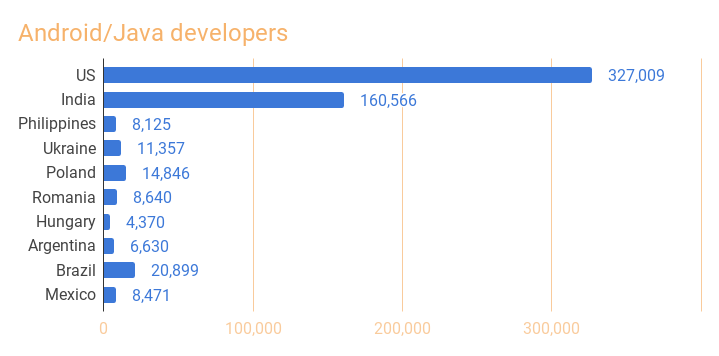
Naturally, not all developers are on LinkedIn, so the actual size of the talent pool is actually larger. With that said, there are three reasons to consider LinkedIn a good enough source of data:
- The data from LinkedIn is public and easy to verify.
- LinkedIn allows for precise targeting of all mainstream programming languages relevant for mobile development. This allows for a more accurate comparison across technologies. This also makes it a better source that the reports from Stack Overflow (which leave out newer technologies like Flutter and React Native).
- Most software development specialists with accounts on job marketplaces (like Upwork, Freelancer, or Toptal) are likely to be on LinkedIn.
With this in mind, let’s use LinkedIn to explore talent supply in other mobile development technologies.
Kotlin
Kotlin is, effectively, a new kid on the block in Android. It’s slowly becoming a more popular programming language amid Google’s attempts to steer away from Oracle. Nevertheless, Kotlin is not even starting to catch up with Java as of 2018.
Right now, LinkedIn has “only” 23,083 Android engineers specializing in Kotlin. Out of these, a little over 3K reside in the US. India has a little over 3K Android/Kotlin developers, too. As for other destinations, it seems like they are only beginning to adopt the technology.
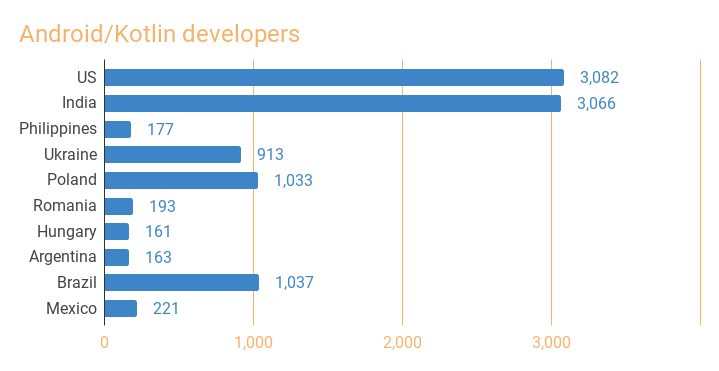
Knowing it’s been a year since Google adopted Kotlin, we’ll surely see more Kotlin developers in the future. This growth will likely come from Java Android developers migrating to Kotlin.
Demand for tech talent in Android development
Speaking of demand, how many companies are looking for Android engineers right now? One way to answer this question is by looking at open Android development positions at job websites. For this article, we’ll take the data from LinkedIn, Glassdoor, Indeed.com, and Monster.com. We’ll also compare the number of open positions for Android/Java and Android/Kotlin development:
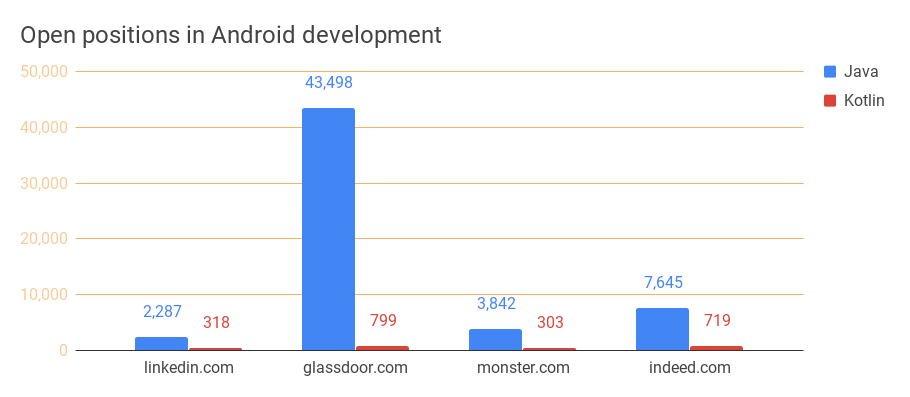
Biggest software development trends in Android development
There’s always an inherent link between hiring trends in tech and software development trends. New announcements in a technology indicate what skills might become more relevant in the near future.
With its heavy focus on mobile, Google I/O 2018 showcased what companies will want to build in 2018 and beyond. With this in mind, let’s briefly recall what’s new in Android.
- ML Kit. A Firebase SDK for machine learning, ML Kit brings image, text, speech, landmark, and face recognition to mobile. This means experience with ML Kit can soon become must-have for applications of all sorts.
- ARCore in instant apps. A giant leap for e-shopping, AR-enabled instant apps will showcase products in augmented reality without the need to download anything.
- Companion Actions in Google Assistant. Companion Actions allows users to access the functionality of the apps they didn’t install. Marketed as engagement boosters, actions are yet another step towards the adoption of instant apps.
- Instant games (Google Play Instant). Applications of this type offer rich non-downloadable demos of in-game experience to boost user engagement. Skills-wise, instant games will make Unity more relevant for Android.
- Android Things. With Android things, Google streamlines the development of smart connected devices and IoT applications.
With instant apps growing in prominence, Google also places a heavy focus on AI/ML, IoT, and AR. As these innovations wind their way into mobile, more companies will want to have them in their apps. So is it time for companies to start including ML Kit, ARCore, and Android things into the nice-to-have skills lists in their new job descriptions? Time will tell:)
Hiring trends in iOS development
In 2018, it seems like it’s been forever since Swift started to dominate the iOS development market. The number of developers mentioning Swift as their current working language is 185,307. Swift has also become the go-to choice for every new app and new feature built post-2015.
This doesn’t mean, however, that Objective-C has completely lost its ground. As of August 2018, LinkedIn features 114,708 profiles of iOS developers specializing in Objective-C.
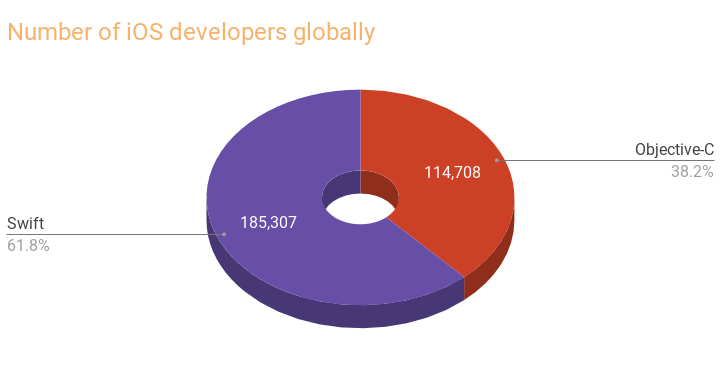
Looking at the market of iOS development, in the US and global destinations, the distribution is similar. Swift dominates in all locations, yet the percentage of Objective-C developers remains significant.
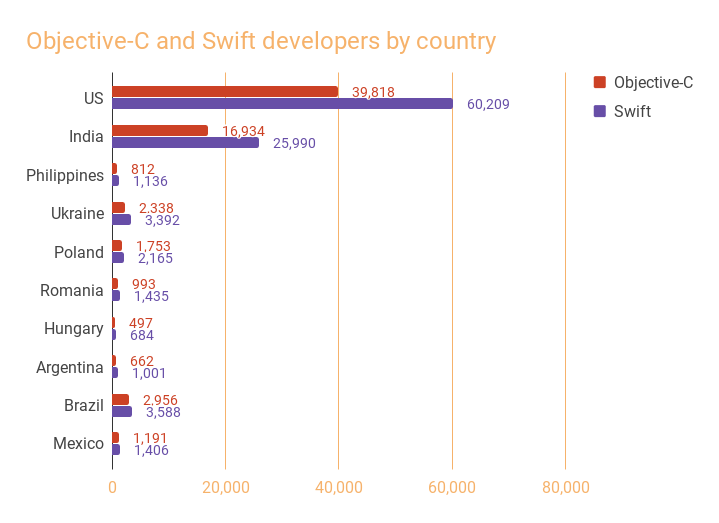
True, this information is nothing new. Still, it will be interesting to see if this gap between Swift and Objective-C will increase in the next 6 months.
Demand for iOS developers
Speaking of demand, companies in the US demonstrate a healthy interest in both technologies. The chart below compares positions that prioritize Swift vs Objective-C. For a more complete picture, we’ll also include all iOS developer job openings (because some job titles either specify both technologies or don’t mention any).
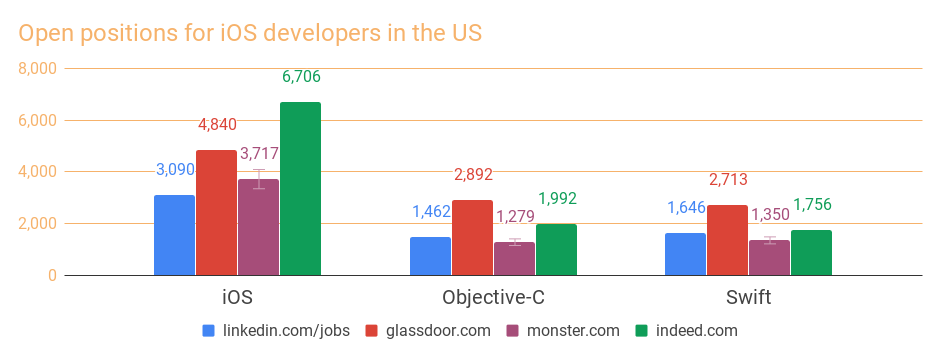
Notice how the gap in demand is narrower compared to talent supply? In part, the reason behind this is the need to maintain existing code. It’s also due to this reason that experience with Objective-C is still must-have for many Swift developers.
Software development trends in iOS
Announced in September 2017, Swift 4 became the biggest news in iOS development in 2017. As for 2018, the latest WWDC sheds some light on what technologies will become more relevant. Much like Google’s Android, the key innovations in iOS revolve around AI/ML, AR, and IoT:
- Core ML 2. Apple newest machine learning SDK for iOS developers is 30% faster, and it enables for 75% lighter AI models. Will these improvements prompt companies to embrace ML on mobile? There’s a big chance they will, as both Apple and Google are going out of their way to entrench AI into mobile experiences.
- ARKit 2.0. The new version of the augmented reality SDK improves face tracking, 3D object detection, and rendering. All of these will offer a better experience for games and AR-based product demos.
- HomeKit, Shortcuts, and Siri. Shortcuts are user-predefined actions available as voice commands for Siri. One reason why this new functionality matters for Apple’s vision of IoT is the integration of Shortcuts with HomeKit. Basically, we’re talking about new functionality that IoT startups will want to support.
Hiring trends in cross-platform mobile development
Another major trend has manifested itself in both Android and iOS development in 2015–2016, as React Native grew popular. The trend is a massive adoption of cross-platform mobile development, with brands like Netflix, Bloomberg, and Wix jumping on the bandwagon. This trend also caused Google to build Flutter, their own framework for cross-platform mobile development.
So how big is the 2018 market for cross-platform mobile development? This chart below examines the talent supply in React Native and Flutter. We’ll also look at Xamarin because technically, it was the first successful technology in the cross-platform mobile space.

Looking at the country level, React Native leads the bunch across all locations. Knowing that Flutter has gone out of beta this spring, this distribution might change in the near future.
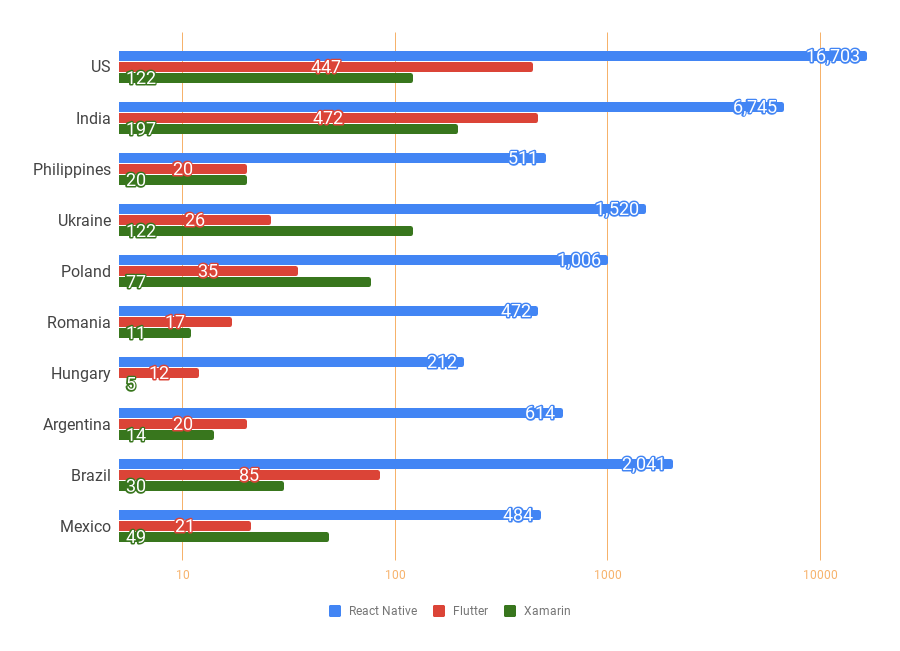
In addition to being more popular with the developers, React Native also enjoys a more active demand. There’s still some demand for Xamarin specialists (partly die the need to maintain existing software).
The small demand for Xamarin mostly reflects the need to maintain existing projects. The small number of job openings for Flutter developers is due to the fact that companies are generally slow to adopt new technologies.

Employment and salary trends that influence mobile development in 2018
Looking at the general trends in software development, LinkedIn and CIO name 5 tendencies that impact talent search and retention:
- High job satisfaction doesn’t prevent employee turnover. CIO names the technology industry among the 6 industries with the highest job satisfaction rates. In the meantime, LinkedIn quotes a record-high turnover of 13% in software.
- Talent shortage. While raw numbers indicate there are thousands of specialists, attracting top talent is a major challenge for 44% of CIOs in the US.
- Hiring is slow. It’s no secret that hiring the right talent takes months for some projects. According to CIO, even staff-level roles take 4.5 weeks to fill, which 41% of companies find unsatisfactory.
- Soft skills grow in importance. For 47% of CIOs, soft skills are a deciding factor when hiring tech specialists. In particular, the ability to maintain productive communications with non-tech colleagues is now a must.
- Remote work and flexible schedules are a bigger thing in 2018. Namely, more businesses are adopting flexible working hours, compressed schedules, and remote work opportunities in addition to perks like social events, gym memberships, and free food. This essentially makes companies accept the same compromises they face when outsourcing business processes to nearshore countries. With this in mind, wouldn’t it make more sense to start hiring globally?
Outsourcing software development in mobile
In 2018, companies like Google, Microsoft, and even NASA hire remote developers to reach top talent in tech. In the mobile space, companies like Samsung, Wix, and Bloomberg are building their iOS and Android apps overseas. If you’re interested in following their example, AgileEngine is one of the top-ranked custom software development firms in the San Francisco Bay Area. We also rank among the top-10 outsourcing companies with dev centers in Ukraine.
We help companies find the very top talent within weeks, and the reviews on Clutch prove that our developers are some of the best in the industry. If you’re looking for mobile developers skilled in native or cross-platform mobile development, contact us and tell us about your app.




